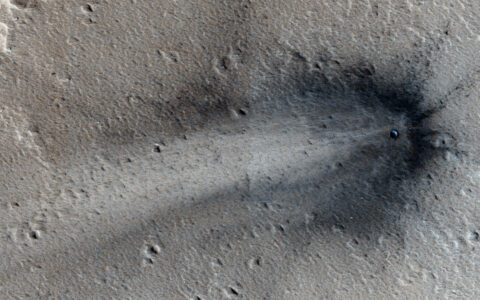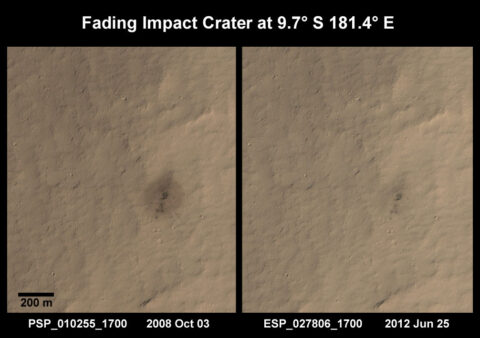Selecting viable landing sites remains one of the most important decisions in planning for the next generation of Mars rovers. The nature of the surrounding terrain will certainly affect the nature of the data they may collect.
Small, fresh impacts expose material that used to lie below the surface. Such exposures would enable rovers to access the shallow subsurface without drilling.
Recently, Thomson and El-Baz [2014] discussed in Eos several attractive potential landing sites, including hydrothermal deposits and locations where drilling might bring organic compounds to light. Either of these two objectives would provide information of considerable scientific interest. Carbon compounds might well be abundant in Mars’s shallow subsurface, and hydrothermal activity may have played an important role in generating the early warm, wet phase of Martian geologic history [Shaw, 2008].
I suggest an additional consideration I have yet to see put forward to complement both suggestions: landing rovers close to one of the very recent Martian craters. These small, fresh impacts expose material that used to lie a few meters to tens of meters below the surface. Such exposures would enable rovers to access the shallow subsurface without drilling, to a depth significantly greater than could be reached with a drill.
What Impact Sites Would Work?

Several such impact sites have been identified [Malin et al., 2006; Daubar et al., 2013], and even targets chosen for other reasons may be close enough to a recent crater for a rover to directly sample the material ejected around the margins of the crater (as seen to the right and above). Rovers could perhaps even sample the crater floor itself, depending on the nature of the crater’s rim.
The dark excavated material, formerly from the subsurface, may well contain significant amounts of carbonaceous material, which would be of great astrobiological interest.
Craters Provide a Key Advantage
Targeting recent impact craters is not simply a matter of convenience—it may even be necessary. Although some think that “digging” or even shallow drilling can expose organics present in the shallow subsurface, it may not be possible with current technology to drill deep enough in most locations for that purpose. Mars’s surface has been subject to a certain amount of “processing”: The wind removes and redeposits material, which could clearly involve removing or oxidizing near-surface organics to some unknown depth.

These processes occur at impact craters too, but the advantage there is that large amounts of material have recently been dug out of the craters. For example, the image to the left shows how the dark deposits appear to fade rather quickly over time, which could be due to the oxidation of exposed dark organic compounds by atomic oxygen in the Martian atmosphere.
Although such oxidation after the passage of even a few years will have altered the ejecta material, readily accessible ejecta fragments from just below the surface would be essentially pristine. In addition, fragments could be “scrubbed” to reveal their more pristine interiors.
What If We Don’t Find Definitive Proof of Life?
Prebiotic compounds could provoke us to consider the extraordinarily interesting question: Why did life not emerge on Mars?
I hasten to point out that organic compounds of possible biologic interest found in crater ejecta (or, for that matter, their discovery elsewhere on Mars) would not necessarily indicate either past or current life on Mars. We know that abiotic atmospheric and surface chemistry can produce a surprisingly complex array of biochemical precursor compounds, which in the case of Earth no doubt preceded the emergence of life.
Assuming that similar processes acted on Mars, samples of possible biological interest would flip our thinking. Instead of raising questions about where the life on Mars went, potentially prebiotic compounds would provoke us to consider the extraordinarily interesting question: Why did life not emerge on Mars?
References
Daubar, I. J., A. S. McEwen, S. Byrne, M. R. Kennedy, and B. Ivanov (2013), The current Martian cratering rate, Icarus, 225, 506–516.
Malin, M. C., K. S. Edgett, L. V. Posiolova, S. M. McColley, and E. Z. N. Dobrea (2006), Present-day impact cratering rate and contemporary gully activity on Mars, Science, 314, 1573–1577, doi:10.1126/science.1135156.
Shaw, G. H. (2008), Earth’s atmosphere—Hadean to early Proterozoic, Chem. Erde, 68(3), 235–264, doi:10.1016/j.chemer.2008.05.001.
Thomson, F. J., and F. El-Baz (2014), Future Mars rovers: The next places to direct our curiosity, Eos Trans. AGU, 95(35), 313–314, doi:10.1002/2014EO350001.
Author Information
George H. Shaw, Department of Geology, Union College, Schenectady, N.Y.; email: [email protected]
Citation: Shaw, G. H. (2015), Craters could make great impacts on Mars exploration, Eos, 96, doi:10.1029/2015EO032527. Published on 23 July 2015.
Text © 2015. The authors. CC BY-NC 3.0
Except where otherwise noted, images are subject to copyright. Any reuse without express permission from the copyright owner is prohibited.

